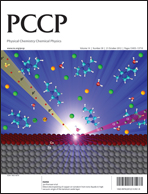Solute–solvent hydrogen-bonding in room temperature ionic liquids studied by Raman spectroscopy†
Abstract
The vibrational frequencies of the C![[double bond, length as m-dash]](https://www.rsc.org/images/entities/char_e001.gif) O + C
O + C![[double bond, length as m-dash]](https://www.rsc.org/images/entities/char_e001.gif) C band of
C band of ![[double bond, length as m-dash]](https://www.rsc.org/images/entities/char_e001.gif) O + C
O + C![[double bond, length as m-dash]](https://www.rsc.org/images/entities/char_e001.gif) C stretching mode were compared with Kamlet α values, and frequency shifts of the NH2 stretching mode were compared with Kamlet β values. A nearly linear relationship was obtained for both parameters, although the solvatochromic parameters were more sensitive to changes of the
C stretching mode were compared with Kamlet α values, and frequency shifts of the NH2 stretching mode were compared with Kamlet β values. A nearly linear relationship was obtained for both parameters, although the solvatochromic parameters were more sensitive to changes of the


 Please wait while we load your content...
Please wait while we load your content...